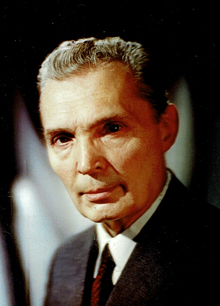Maurice Bonnet
Maurice Bonnet was a French photographer specializing in autostereoscopy, or direct-view stereoscopic photography, and integral imagery.
He founded a company called La Relièphographie, which produced 3D photographs, about 33 well-known ones in total. All of these thirty-three-image photographs give an excellent and immediate sensation of depth unlike any provided by two-image stereoscopy.[1]
Biography[edit]
Maurice Bonnet was born on April 18, 1907, in Asnières-sur-Seine, France. He came from a family of photographers.[2]
He became renowned among specialists in stereoscopic photography for his work on so-called autostereoscopic processes, or lenticular imaging.
In 1931, Bonnet began modifying and refining Gabriel Lippmann's Integral Photography.
In 1937, he founded the company La Relièphographie to commercialize his processes, notably in the form of advertisements[3]. In 1942, La Relièphographie opened a stereoscopic portrait studio on Avenue des Champs-Élysées in Paris and had high-precision photographic cameras and lenticular screens made for the production of stereoscopic photographs.[4]
The portraits from the Champs-Élysées studio were quickly recognized as masterpieces of autostereoscopic photography. They were captured with a camera called the O.P. 3000, which moves in an arc in front of the subject[5]. La Relièphographie's reputation enabled it to sell its equipment to photographers around the world. Thus, in the early 1950s in the United States, Paul Hesse and Harvey Prever created lenticular photographs to promote 3D films.[6]
After the closure of La Relièphographie's studio in the early 1950s, Maurice Bonnet focused on developing scientific applications of his processes. As early as 1939, the ministère des Armées and the CNRS had shown interest in the potential military applications of this process, particularly in the fields of aerial photography and cryptography. In 1961, Bonnet joined the CNRS and established the Waffle Film Laboratory, which was attached in 1966 to the Service of Inventions and Applied Research[7], and later to ANVAR. In France, the companies Publirama (1955-1961), Relieforama (1967-1972), and Formes et Espace (1970–around 1977) used his processes.
His photographs were showcased at the Exposition universelle de 1967 in Montreal and the Exposition universelle de 1970 in Osaka.
Throughout his career, he filed more than 400 patents.
External Links[edit]
Notes and references[edit]
- ↑ Timby, Kim (2015-07-31). 3D and Animated Lenticular Photography: Between Utopia and Entertainment. Berlin ; Boston: Walter de Gruyter GmbH & Co KG. ISBN 978-3-11-044795-8.
- ↑ Michèle Bonnet, Entrelacs biographiques, Maurice Bonnet et la photographie en relief, mémoire de maîtrise, Université de Toulouse-Le Mirail, 1996.
- ↑ Kim Timby, « Images en relief et images changeantes. La photographie à réseau ligné », Études photographiques, Template:N°, May 2001, Template:P..
- ↑ Michel Frizot, « Les réseaux lenticulaires et le procédé Bonnet », in Template:Ouvrage.
- ↑ Template:Ouvrage
- ↑ Template:Ouvrage
- ↑ His career file at the CNRS is kept at the National Archives in Fontainebleau under reference 20070296/59.
